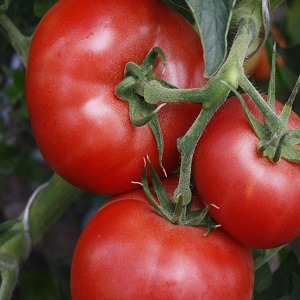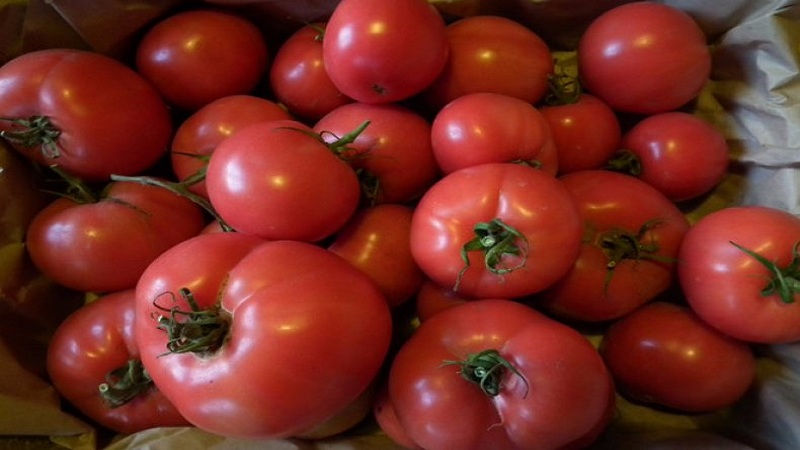Wonderful tomatoes for greenhouses and hotbeds: the "Masha Doll" tomato
A hybrid tomato with an interesting name Doll Masha and high yield rates is popular with farmers and consumers. Early amicable ripening allows you to enjoy tomatoes already in the middle of summer.
The article describes the peculiarities of cultivating a hybrid in greenhouses, its advantages and disadvantages.
The content of the article
Description of the hybrid
Doll Masha f1 is an early ripe hybrid created by breeders of the Russian Agrofirm SeDeK for cultivation in film-type greenhouses and hotbeds.
Determinant bushes do not require pinning and molding.
In the photo - the tomato Doll Masha f1.

Fruit characteristics
| Indicators | Characteristic |
| Weight | 200-300 g |
| The form | Flat-round, slightly ribbed |
| Coloration | Pink |
| Leaves | Large size, green |
| Inflorescence | Simple |
| Number of nests | 4-6 |
| Pulp | Fleshy, juicy |
| Taste | Very sweet, with a slightly perceptible sourness |
| Skin | Dense, shiny |
| Appointment | Universal |
| Bushes height | 0.5-1 m |
| Ripening period | 80-90 days from the moment of emergence |
| Yield | 8-10 kg / m² |
| Sustainability | To verticillosis |
| Transportability | Excellent |
How to grow seedlings
The hybrid is grown through seedlings in the standard way: sowing seeds into the ground with further picking into individual containers. The procedure is carried out from late March to early April.
Soil preparation and sowing seeds
Hybrid seeds are processed in production before being packaged in bags, therefore, at home, they are not manipulated to disinfect and increase germination.
Experienced farmers advise sizing seeds. This will help identify empty and too small grains. To do this, the seed is soaked for 5-10 minutes in salt water (1 tsp per 200 ml). Anything that has surfaced is not suitable for sowing. The seeds remaining at the bottom are gently washed with warm water.
Land for seedlings can be obtained from a gardening store. This substrate is already enriched with nutrients. Most gardeners prefer to prepare the soil on their own from a mixture of black soil, river sand and peat in a 1: 1: 1 ratio. Superphosphate is suitable as a fertilizer - 40 g per bucket of earth.
Council. Before use, the soil is heated in an oven at a temperature of 110 ° C or steamed in a double boiler. A strong solution of potassium permanganate will disinfect the soil and prevent the growth of bacteria.
For growing seedlings, boxes, trays, containers, tetrapaks, pots 5-7 cm deep are suitable.They are filled with moist soil and seeds are sown into furrows 1.5-2 cm deep with an interval of 2 cm.
The containers are covered with plastic wrap and placed in a dark place. The optimum temperature for seed germination is 23 ° C. In such conditions, seedlings will appear after 4-5 days.
Seedling care
After the seeds hatch, the film is removed, the boxes are taken out on the windowsill on the south side. To prevent seedlings from stretching up, the duration of daylight hours should be at least 16 hours. If there is little sunlight, the seedlings are placed under fluorescent lamps.
Water as needed: 1-2 times a week. An egg shell infusion is suitable as an additional feeding. It is simple to prepare it: a shell of 10 eggs is poured into 3 liters of water and insisted for 6-7 days. A cloudy liquid and a characteristic odor indicate that the fertilizer is ready. The infusion is used for watering seedlings once a week.
A week before planting in the ground, the seedlings are taken out into fresh air for hardening for half an hour.
The lower leaves are cut off as they grow, the seedlings are spud to strengthen the rhizome.
How to grow tomatoes
Determinant hybrid Doll Masha needs timely watering, loosening, weeding, application of organic and mineral fertilizers, additional lighting in case of lack of sunlight.
Landing
Seedlings are transferred to a permanent place in a greenhouse or greenhouse from May to June. By this time, the height of the seedlings should be 30 cm, the thickness of the stem - 1 cm.
Important! The producer of hybrid seeds Kukla Masha recommends cultivating the tomato indoors. The culture loves warmth and reacts painfully to sudden jumps in the average daily temperature. Those who tried to plant the hybrid outdoors were disappointed with the result.
The soil is prepared before the planting begins: it is dug up, the top layer of 5-10 cm is removed, and treated with a hot solution of copper sulfate (1 tbsp. L per 10 l of water).
Tomatoes prefer loamy or sandy loam soil. For 1 m², add 3 buckets of a mixture of peat, sawdust and humus in a 1: 1: 1 ratio. Then add mineral fertilizers: 3 tbsp. l. superphosphate, 1 tbsp. l. potassium sulfate, 1 tbsp. l. potassium magnesium, 1 tsp. sodium nitrate, 2 glasses of ash per 1 m².
On the plot, holes are dug 15-20 cm deep, poured with boiling water, and after the soil has cooled, seedlings are planted.
Planting scheme - 40x60 cm, 4-5 seedlings per 1 m².
Care
The hybrid needs constant care in the form of watering, weeding, loosening the soil and timely fertilizing with mineral compounds.
For successful cultivation, it is recommended to follow the rules of tomato care:
- The first week after planting, tomatoes are given time to adapt to a new place - they do not water, do not spud.

- The first watering - after 7 days, with warm settled or rainwater, watering strictly to the root, in the afternoon.
- The first time, watering should be moderate - once a week. After the appearance of ovaries, the frequency is increased up to 2 times, 4 liters for each bush.
- The soil is loosened to a depth of about 10 cm for better heating and oxygenation. The procedure is repeated after each watering, but already to a depth of 5 cm.
- To reduce the amount of watering and better nutrition of the root system, the soil is covered mulch - sawdust, peat, pine needles, straw.
- Bushes do not stepchild or form. For support, wooden stakes are dug in next to them for garters of brushes with heavy fruits.
- Plants are spud to strengthen the root system.
To stimulate growth and abundant fruiting, the hybrid is treated with synthesized phytohormones:
- Zircon, Ekogel - universal preparations;
- "Immunocytofit" - strengthens the immune system, helps to fight diseases, is safe for plants and people;
- "Kornevin" - stimulates the growth of roots.
Tomato feeding scheme:
- One and a half to two weeks after planting: 1 tbsp. l. nitrophosphate, 500 ml mullein per 10 liters of water. For one bush - 1 liter of solution.
- Subsequent feeding is carried out every 2 weeks with potassium sulfate and the drug "Fertility" (1 tsp. Potassium sulfate, 1 tbsp. L. Drug per 10 liters of water). The frequency of fertilization is 3 times during the growing season.
Features of cultivation and possible difficulties
When cultivating tomatoes in a greenhouse or greenhouse, it is important to adhere to the temperature regime:
- during the day - no higher than 26 ° С;
- at night - not lower than 16 ° С.
Reference. At air temperatures above 26 ° C, flowering and ovary formation are suspended. At 32 ° C, pollen becomes sterile.
Indoor humidity should be 60-70%. To normalize the microclimate, greenhouses and hotbeds are often recommended to be ventilated.
The Kukla Masha hybrid is demanding on lighting, so a site on the sunny side is chosen for planting bushes. In the northern regions, it is recommended to install additional light sources in greenhouses - fluorescent or LED lamps.
Diseases and pests
The hybrid is immune to verticillosis, rarely gets sick late blight (brown spots and white bloom on leaves, stem, fruit deformation) due to early ripening.
Measures for the prevention of "tomato" diseases allow you to maintain plant health and get a rich harvest:
- in autumn, greenhouses are treated with sulfur checkers;
- in the spring they disinfect the earth with copper sulfate (50 g per 10 liters of water, 2 liters per 1 m²);
- the soil is covered with mulch (sawdust, peat, straw, needles);
- the lower leaves are removed;
- comply with the watering rate;
- monitor the humidity level in the greenhouse.
Tomato greens attract Colorado beetles, aphids, spider mites, whiteflies. Insecticides come to the rescue: "Confidor", "Borey", "Iskra", "Aktarra", "Epin", "Commander".
Folk remedies are no less effective:
- Wood ash. For 10 liters of water, 50 g of ash, 50 ml of liquid soap. The mixture is infused for 5-6 hours, filtered through cheesecloth and the bushes are treated every 2 weeks.
- Tobacco. For 10 liters of boiling water, 400 g of shag. Insist 48 hours, then use it to irrigate greens 3 times - every 3 days.
- Onion peel. For 10 liters of water 200 g of raw materials. Insist 6-8 hours, mix 50 g of tar soap shavings. Applied for spraying 1 time in 7 days.
Harvesting and application of the crop
Harvesting begins in July and ends at the end of August.
Tomatoes are used for making vegetable salads, sauces, pasta, juice, adjika, lecho. Medium-sized fruits are pickled or salted in jars for the winter.

Advantages and disadvantages
Pros of a hybrid:
- early and friendly ripening of tomatoes;
- excellent taste;
- resistance to verticillosis;
- unpretentious care;
- universal use of fruits in cooking;
- high productivity;
- there is no need to pinch and form bushes;
- the possibility of cultivation throughout the territory of Russia;
- keeping quality and the possibility of transportation.
Disadvantages:
- not suitable for outdoor cultivation;
- the plant is demanding on light, with its deficiency it needs additional lighting.
Reviews
The impressions of large farmers and amateur gardeners from growing a domestic hybrid are positive.
Evgeniya, Tambov: “I plant the doll Masha tomatoes in a greenhouse according to the manufacturer's recommendation. I'm happy with the result. The fruits are large, juicy and sweet. Can be used for conservation. Culture care is not difficult. It is important to water in moderation, avoiding waterlogging, and plant on the southern side of the site. I feed it with mullein and ready-made mineral fertilizers with potassium and phosphorus. "
Pavel, Tikhvin: “The hybrid Doll Masha is only suitable for indoor use. Two years ago, for the sake of experiment, I planted several bushes in the garden. Plants could not withstand the temperature drop: they did not bloom and dried up. I installed LED lamps in the greenhouse, since there is not enough sunlight in our area. The yield is high, I collect up to 7 kg of tomatoes from one bush. The taste for the hybrid is excellent. The yield and other qualities correspond to the description of the variety (more precisely, the hybrid) from the manufacturer. "
Conclusion
Doll Masha f1 - one of the best undersized domestic hybrids for cultivation in greenhouses. The culture does not require special care skills, only timely watering, loosening the soil and applying organic and mineral fertilizers. The tomato is resistant to verticillosis and rarely becomes infected with late blight due to early ripening. The culture is popular with farmers and consumers due to its taste, keeping quality and the ability to transport over any distance.